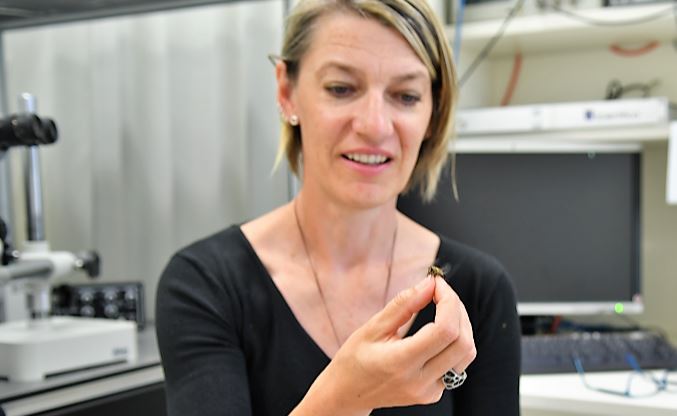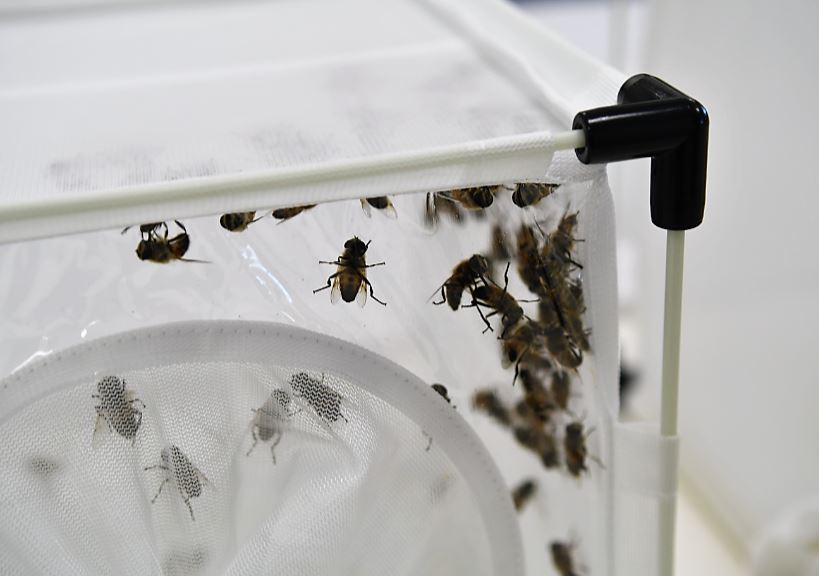
The size of a tiny insect brain bears no comparison to the super capacity of its killer instinct and flying skills and speed.
Just like in humans, the brains of hoverflies and even tiny predatory robberflies have hundreds of thousands of neurones which give them survival abilities for hunting and pollen collecting unparalleled even in the most advanced human technologies.
And just like humans, the descending nerve (or ‘spinal cord’) in flies narrows down to channel only a few hundred neurones at a time.
So how can these extraordinarily rapid insect responses to visual and other sensory cues occur when the body’s pre-motor pathways run into such a bottleneck linking messages from the brain to the wings and body?
New research from insect neuroscience specialists at Flinders University and the University of Minnesota and Cambridge University is looking to unlock this mystery.
Funded by the US Air Force Office of Scientific Research and an Australian Research Council Discovery grant, the collaborative research efforts are looking for future directions in neuroscience from the study of highly advanced flying insects, such as predatory robberflies and dragonflies, and non-predatory hoverflies and bees.
The latest study, analysing the descending nerve (which runs along the ventral of underside of the insect) in flies, will lead to more research to mimic the response time in predatory and non-predatory insects in their natural environment in the wild.

“Humans are quite poor at responding to small stimuli in a busy or cluttered field of vision, such as catching a ball while running in a forest,” says Associate Professor Karin Nordström, from the Neuroscience Centre at Flinders University’s College of Medicine and Public Health.
“So how can flies see each other in similar environments?
“Clearly, there is something in their evolution that still enables incredibly fast responses in their behaviour when their brain registers a trigger (such as pollen, a potential mate or a yummy meal).”
As well as recording responses in the brain, the researchers are also looking at how the animals’ neurones dictate behaviour and translate into their super sophisticated capabilities.
Research findings will help to inform future technologies such as driverless cars and more efficient modes of air travel.
“This latest study is also fascinating because the tiny robberfly and larger (bee-size) hoverfly have very different evolutionary coding but very similar descending nerve cords, so we are now working on understanding the common blueprint for target detection,” Associate Professor Nordström says.
“Indeed, animal brains can be seen as biological computing machines, and many current machine learning tools, including deep neural networks, are heavily inspired by neuroscience using a similar architecture with many layers of non-linear interactions.”
The paper, ‘Integration of Small- and Wide-Field Visual Features in Target-Selective Descending Neurons of both Predatory and Non-Predatory Dipterans’ 2018 by Sarah Nicholas, Jack Supple, Richard Leibbrandt, Paloma T Gonzalez-Bellido and Karin Nordström has been published in the Journal of Neuroscience.
See more information and research blogs at the Hoverfly Vision website.

